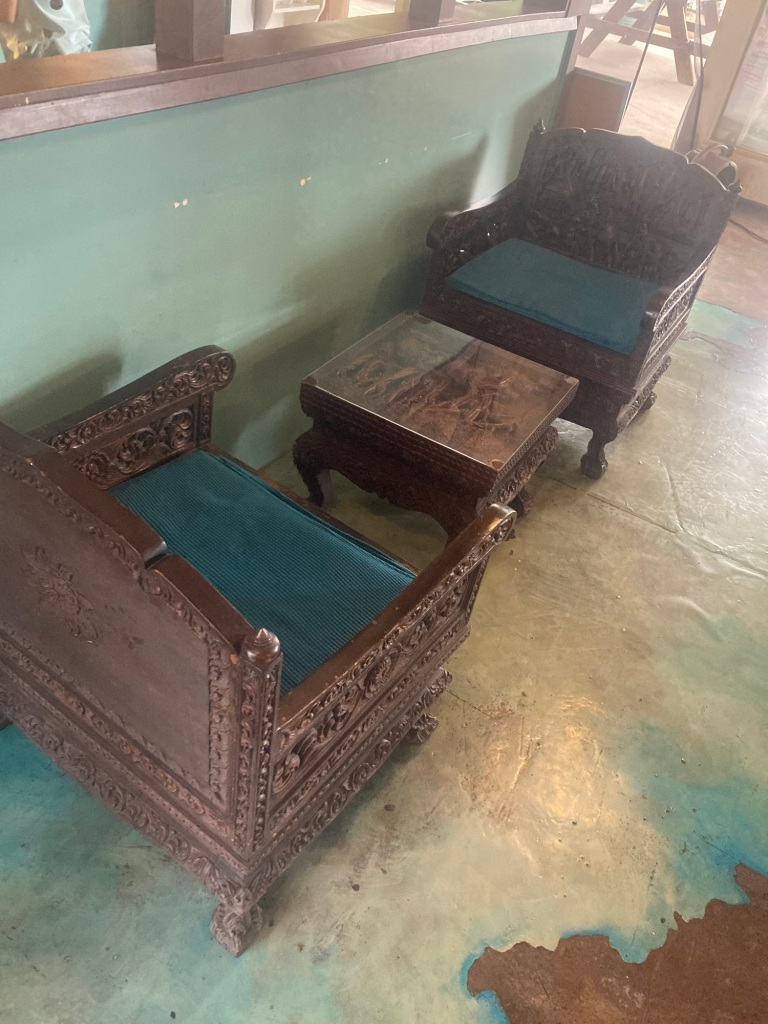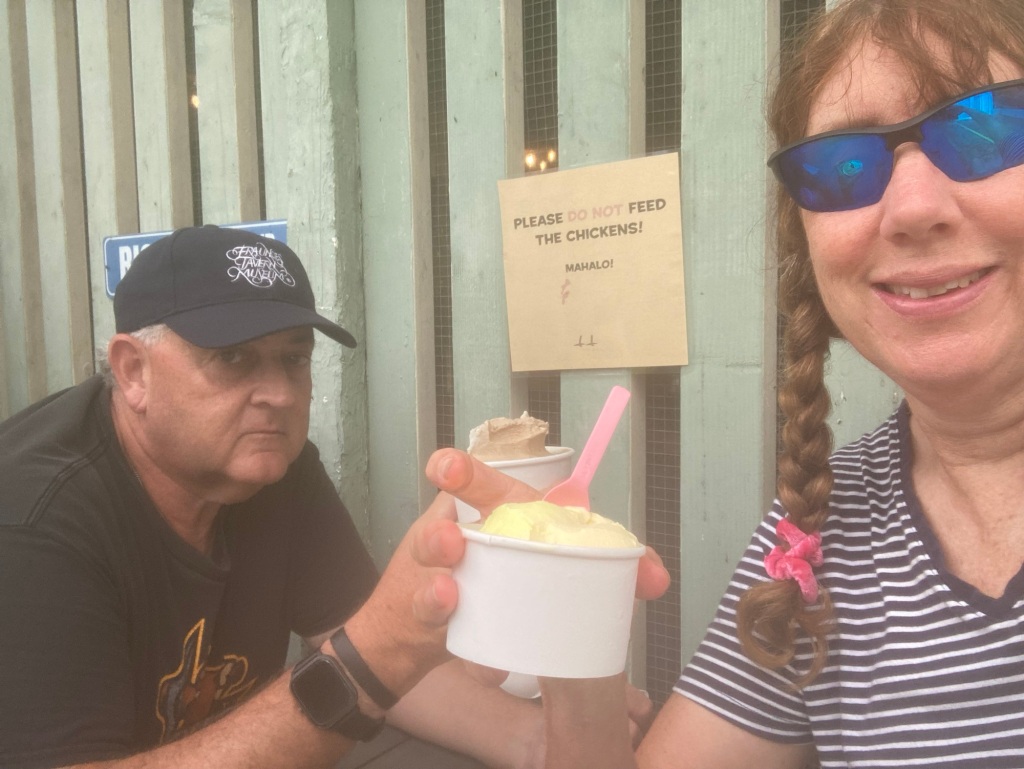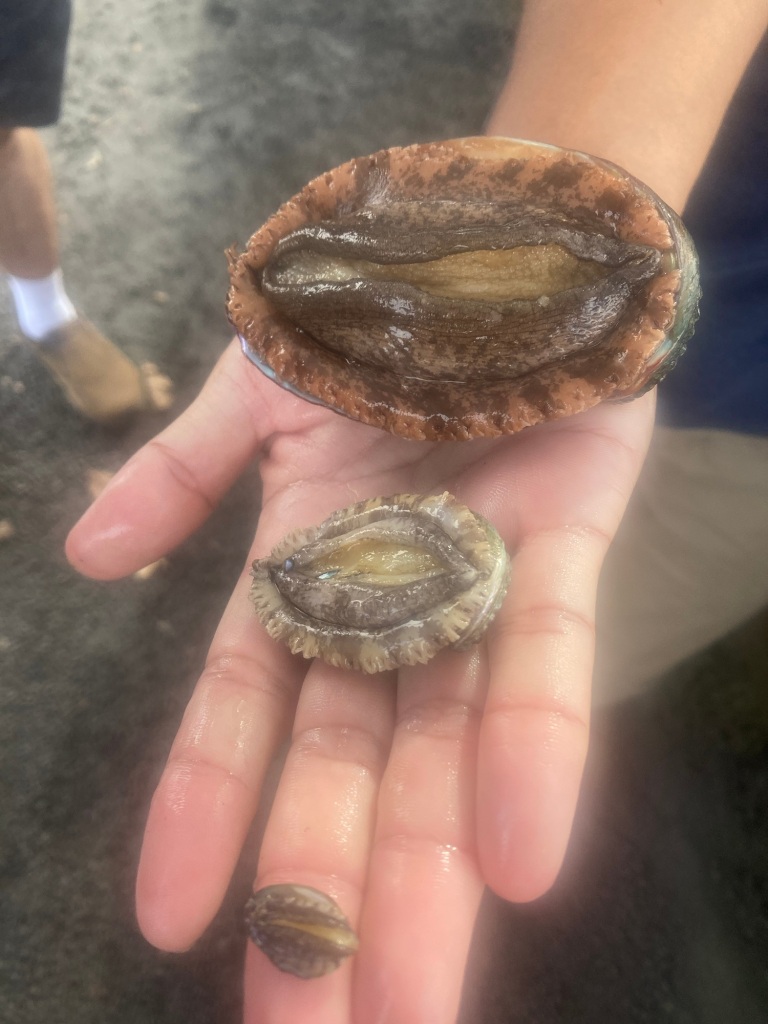(Big Island Abalone. Greenwell Farms, Kona Salt Farm)
October 16, 2023
Gypsea Gelato, Kealakekua, Big Island, Hawaii

Gypsea Gelato was an interesting place where one could come for the ice cream (or gelato) or expresso and stay to play Connect Four or corn hole, shop for a new hat, look at artwork or sit on a comfortable chair to read a book or play on their cell phone – an ice cream shop that has it all! Seating included a wooden boat with plenty of children’s books, large tables for groups, and padded throne-style chairs.

There were plenty of frozen treats to enjoy including Hawaiian favorites such as “Macadamia Nut”, “Tom Kha” (coconut), “Kona Coffee” and “Lilikoi” (passion fruit) and more traditional flavors including “Just Chocolate”, “Just Dark Chocolate” and “Salted Caramel” , I went with Lilikoi. I found texture to be creamy, but the flavor a bit weak. We enjoyed our treats inside since it was drizzly outside.

In the area – today we went on two factory tours and one farm tour, All were wonderful and I highly recommend them,
Big Island Abalone, Kona, Hawaii -Abalones are edible mollusks with ear shaped shells. In addition to being an important food source in many parts of the world. their colorful, iridescence-lined shells make them attractive for use in jewelry. Big Island Abalone aquafarrm is an abalone grower that offers tours of their facility.

Our tour began with an introduction to our tour guide – a very interesting and knowledgeable scientist from Japan. He introduced us to the abalones by showing us the life cycle from eggs to the harvestable mollusks. We then walked through rows of tanks as he explained how the fish are raised. As the abalones grow, they are moved between tanks until ready to harvest. They are fed seaweed, which is grown in separate tanks which we also shown.
After the tour of the abalones and seaweed growing area, our guide brought us to a tank with other interesting sea creatures that they keep solely to show tourists, The tour was followed by the tour guide preparing abalones in two different ways and giving us samples to try, with sea grapes for garnish. I never had abalone before, and I liked it, but the the rubbery texture would take some getting used to. The sea grapes were fun to eat.
Kona Salt Farm, Kona, Hawaii -Sodium chloride, often referred to as “Salt” is an essential component of our diets -we need it to live, but too much is obviously not good for us. Salt used in cooking may come from a variety of sources, such as underground salt beds and seawater extraction. Today we toured Kona Salt Farm, a seawater extraction facility .

Due to the volcanic formation of this area in Hawaii, the ocean becomes very deep very near the coast. It is here that the Kona Salt Farm gets seawater for salt – specifically 2200 feet below the ocean surface, where the salt is cleaner and richer in minerals than salts mined closer to the surface.

Our tour guide started by showing us the scenic Pacific Ocean coast by the farm, and taking our pictures by the beautiful back drop, Then she got down to explaining of the technical side of salt production. We saw from a distance where the clean, cool salt water was brought up from the deep ocean, and then headed to the drying facility. The deep sea water went through a series of evaporation steps to obtain the pure, healthy salt.
The different qualities of salts including finishing salt, coarse salt and first flake salt were discussed and shown to us – all chemically the same, but with different textures. We were then given a chance to try and buy the resulting salts at the end of the tour, including flavored salts where additional ingredients were added to flavor to the used in cooking or serving.
Our tour guide was friendly, knowledgeable and very happy to show us the amazing process. a tour I highly recommend.
Greenwell Farms, Kealakekua, Hawaii – The volcanic soil, the climate and the winds and weather patterns on the Big Island of Hawaii all come together to produce some of the best coffee in the world, known as “Kona Coffee”. We stopped at Greenwell farms for a tour of coffee-growing plantation.
The coffee plants produce white flowers followed by green berries which happened before we arrived. The green berries then produce red fruit called “cherries”. Our tour guide gave each one of us a cherry and we removed the outer fruit to reveal an inner seed known as the coffee bean, covered with a slimy layer. Commercially removing the outer coating is done using a “pulper”, which our guide he showed us, The next steps in the process are a short fermentation, rinsing and sun drying. We saw the beans going through each step ending with beans drying on big trays in the sun. We learned about the different grades of Kona Coffee and challenges in growing the crop. We were able to sample some of the various coffee products in their small store.
But Greenwell farms did not just grow coffee, they had several other crops that thrive in the warm. moist Kona environment, the most interesting to me being bananas and black pepper.

The bananas grew on a row of very tall trees with a common root system. Each year all the plants were torn down and regrown. Fascinating that they could grow that tall in one year. The rows of black pepper plants with the clumps of peppercorns were in the process of ripening were also present.